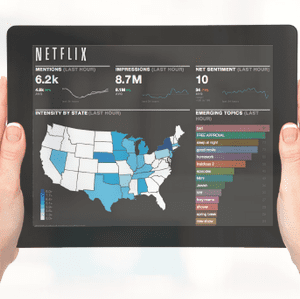Topics
How To Get Real Value Out Of Video

Time-starved, multitasking B2B marketers are seeking more interactive and compelling content to drive brand awareness, encourage conversations and, as a result, generate more leads and sales.
Buyers’ attention spans are continuing to shrink and their schedules are becoming more hectic. As a result, marketers need to implement strategies that provide quick-hitting information that resonates with the wants and needs of specific audiences.
According to results from Demand Gen Report’s 2013 Content Preferences Survey, 50% of respondents watched a video to research B2B purchasing decisions in the past 12 months. The vast majority (80%) also somewhat or strongly agree that they now prefer interactive content, such as audio podcasts and videos, which can be accessed on demand.
“The statistics are clear that video drives better engagement with online audiences, and present a great opportunity to engage with buyers,” said Jason Thibeault, Senior Director of Marketing Strategy at Limelight Networks, an organization that helps B2B enterprises improve their digital marketing strategies. He added that with video, visitors stay on pages longer, and in turn, are more apt to purchase.
However, organizations still are not fully educated on how to utilize video effectively, Thibeault noted. Moreover, with the emergence of new social networks such as Twitter’s Vine, organizations are contemplating how video can amp up content marketing strategies, and the role the medium will play in overall lead generation and nurturing efforts.
“The barriers to creating and integrating video with traditional content have crumbled,” Thibeault explained. “But organizations need the ‘how-to’ on using video effectively. There’s a big black hole in the changing landscape of digital marketing with respect to B2B video best practices.”
Using Video For ‘To’ And ‘Through’ Partner Marketing
Video is an effective medium to educate both partners and prospects on new solutions, best practices and leading industry trends.
From a “to-partner” marketing perspective, channel executives are primarily tapping video to educate partners. The key challenge is “bridging that gap to enable partner-facing teams to use video to communicate to partners,” noted Heather K. Margolis, Founder and President of Channel Maven Consulting, “and to help partners to market and communicate to their end customers.”
Similarly, partners are considering the benefits of using video to power up their own sales and marketing efforts. However, creating and publishing videos just for the sake of it is a large mistake being made by many organizations, according to Josh Medeiros, VP of Professional Services at Marketing Advocate.
“We have found that the most successful channel partners are using video at certain stages of the buying process with their prospects and existing customers,” Medeiros said in an interview with Channel Marketer Report. “Also, these partners are automating the distribution of video based on user actions, interests and decision making role.”
In order to optimize marketing efforts in this emerging medium, organizations must consider the role that video plays within the context of an overall marketing plan. Then, videos must be “tailored to convey the right messages and should be disseminated at the right time to the right people,” Medeiros added. “Just like any other marketing vehicle.”
Four Video Marketing Best Practices
The digital ecosystem is swarming with content. As a result, B2B organizations are striving to cut through the noise, and utilize resources that are relevant to their businesses.
To stand out in the crowded online universe, follow these four best video marketing practices, provided by B2B and channel marketing experts:
- Develop a brand story: While it is very easy for organizations to hop on the video bandwagon, it’s important that all clips represent a larger theme or story, according to Thibeault.
“Like any content, video has to adhere to a brand. It has to stay within tone and style,” Thibeault said. “But it also has to connect to a story as a whole. As far as making video compelling all I can say is that B2B buyers are B2C buyers, as well. You have to treat them as people, not as prospects. Video can’t just be about someone using the product or talking about the company. It has to appeal to people individually.”
- Understand viewer wants and needs: Whether videos will be used to educate and engage partners or end-users, it’s important that the entire channel is on the same page in regards to video strategies.
“Make videos that are informative, entertaining, and solve a problem, answer a question, or address a need,” Margolis said. “No one wants to hear a talking head for three minutes. Always ask: Would I want to watch this? Also, it is always better to do three videos that are 45 to 60 seconds than to do one video for 3 minutes. Use case studies as your muse; people want to see and hear real-world examples.”
- Tie video to your content calendar: Video can have a profound impact on partner, prospect and end user engagement it is integrated into all facets of the cross-channel brand journey.
The sheer variety of outlets now available for organizations to share content presents a variety of opportunities to maximize video investment.
“Create a video, post on YouTube, write a blog and embed it, promote the blog on Twitter, a LinkedIn status update, LinkedIn Groups, Google+ and Facebook,” Margolis advised. “Add a blurb to your newsletter, too. If it’s a single video that you feel is very impactful have your team put it in their email signature.”
But in order to deliver the best video to the right prospect and the most effective channel — email, versus social and mobile — Medeiros recommends that organizations lay out videos like puzzle pieces.
“Tag videos using business need, buying stage and role keywords,” Medeiros said. “Then, plan an editorial calendar using email, social, the company web site, YouTube and other channels, and drive contacts back to your site to consume the video.” Once users are on the site, organizations can track, score and build profiles on potential prospects.
- Measure the quality of traffic: As the saying goes, it’s not the quantity of traffic, but the quality, and whether these viewers potentially can become long-term opportunities.
“Don’t aim for viral,” Margolis stated. “Aim for effective. I knew of one vendor’s partner who created a data center tour video and it only had 800 views, but it generated something like 100 leads and close to 20 sales. It was informative and answered questions from customers and moved them through the sales cycle. That’s success!”
Organizations must be able to determine just how engaged viewers are, as well as if and when they drop off. Hosting, managing and delivering video through an online video platform, according to Thibeault, “provides a ton more analytical data enabling marketers to really see what’s happening with their video engagement.”
The Orchestrate Video solution from Limelight was design to do better analyze and quantify video engagement. Coupled with solutions like Marketing Advocate, organizations can close the loop on their video marketing efforts. For example, if a prospect watches a video, and a deal closes as a result, the company can quantify the impact of the video.
“Everything tracks back to sales,” Medeiros said. “Channel partner marketers must be able to connect specific site activities, videos, events, and other marketing activities through to a sale.
Vine And The New Era Of Video
With the continual rise and influence of social media, it is no surprise that video is playing a key role in next-generation social networking.
Vine is a social network and mobile app that allows users to create and share six-second videos. Once videos are created, they are automatically published to a social feed, and users can share their creations with other friends and connections via Twitter and Facebook, and even embed them in emails.
Since the app’s release in January, many B2B organizations such as HubSpot are implementing their own strategies. News outlets and blogs, such as Business2Community and Eloqua’s “It’s All About Revenue” blog have dedicated articles to Vine best practices.
A debate is raging on regarding the value of Vine for B2B organizations. While many retailers and consumer brands, such as Urban Outfitters and Sephora, are adding Vine to their daily social activities, some think there isn’t much potential for less “spontaneous” companies.
“Brands with a lot of energy that would appeal to tech-savvy, early-adopters who are on these video sharing sites,” Thibeault said. “But for most, especially B2B brands, there isn’t a whole lot of value. Vine and other services like it are about spontaneity whereas traditional B2B marketing is deliberate.
However, Medeiros advised that there is a key opportunity for channel organizations to “convey super complicated concepts in seconds to targeted decision-makers. This is powerful because it will allow channel marketers to move prospects to higher levels of interest, faster. The usage of Vine and other like services will speed up the selling process and allow for prospects to ‘get it’ quicker.”
Margolis also noted that Vine hones in on three key benefits: videos are searchable (via hash tags), embeddable, and tweetable. “Why not show a team setting up a booth at an event? Show a time lapse. Or, get a six-second clip from an event keynote. We used Vine at a recent conference to show the friendly faces working at our Social Media Rally Station and it was shared via Twitter and on the conference’s Facebook site.”














